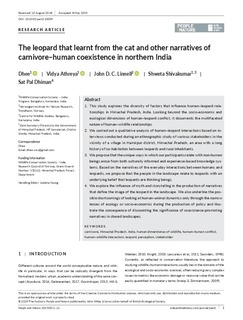The leopard that learnt from the cat and other narratives of carnivore–human coexistence in northern India
| dc.contributor.author | Dhee | |
| dc.contributor.author | Athreya, Vidya | |
| dc.contributor.author | Linnell, John Durrus | |
| dc.contributor.author | Shivakumar, Shweta | |
| dc.coverage.spatial | Himachal Pradesh, India | nb_NO |
| dc.date.accessioned | 2019-07-10T13:01:58Z | |
| dc.date.available | 2019-07-10T13:01:58Z | |
| dc.date.issued | 2019 | |
| dc.identifier.issn | 2575-8314 | |
| dc.identifier.uri | http://hdl.handle.net/11250/2604085 | |
| dc.description.abstract | 1. This study explores the diversity of factors that influence human–leopard relationships in Himachal Pradesh, India. Looking beyond the socio‐economic and ecological dimensions of human–leopard conflict, it documents the multifaceted nature of human–wildlife relationships. 2. We carried out a qualitative analysis of human–leopard interactions based on interviews conducted during an ethnographic study of various stakeholders in the vicinity of a village in Hamirpur district, Himachal Pradesh, an area with a long history of co‐habitation between leopards and rural inhabitants. 3. We propose that the unique ways in which our participants relate with non‐human beings arose from both culturally informed and experience‐based knowledge systems. Based on the narratives of the everyday interactions between humans and leopards, we propose that the people in the landscape relate to leopards with an underlying belief that leopards are thinking beings. 4. We explore the influence of myth and storytelling in the production of narratives that define the image of the leopard in the landscape. We also underline the possible shortcomings of looking at human–animal dynamics only through the narrow lenses of ecology or socio‐economics during the production of policy and illustrate the consequence of discounting the significance of coexistence‐promoting narratives in shared landscapes. | nb_NO |
| dc.language.iso | eng | nb_NO |
| dc.rights | Navngivelse 4.0 Internasjonal | * |
| dc.rights.uri | http://creativecommons.org/licenses/by/4.0/deed.no | * |
| dc.subject | carnivore | nb_NO |
| dc.subject | Himachal Pradesh | nb_NO |
| dc.subject | human dimentions of wildlife | nb_NO |
| dc.subject | human–human conflict | nb_NO |
| dc.subject | human–wildlife interaction | nb_NO |
| dc.subject | leopard | nb_NO |
| dc.subject | perception | nb_NO |
| dc.subject | stakeholder | nb_NO |
| dc.title | The leopard that learnt from the cat and other narratives of carnivore–human coexistence in northern India | nb_NO |
| dc.type | Peer reviewed | nb_NO |
| dc.type | Journal article | |
| dc.description.version | publishedVersion | nb_NO |
| dc.rights.holder | © 2019 The Authors | nb_NO |
| dc.subject.nsi | VDP::Matematikk og Naturvitenskap: 400::Zoologiske og botaniske fag: 480 | nb_NO |
| dc.source.journal | Plant and Nature | nb_NO |
| dc.identifier.doi | 10.1002/pan3.10039 | |
| dc.identifier.cristin | 1711128 |
Tilhørende fil(er)
Denne innførselen finnes i følgende samling(er)
-
Scientific publications [1392]
Vitenskapelige artikler, kapitler og monografier i Open Access.

